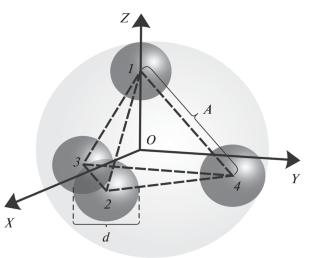多核小粒子的磁化:理论与计算机建模
IF 0.48
Q4 Physics and Astronomy
Bulletin of the Russian Academy of Sciences: Physics
Pub Date : 2024-10-29
DOI:10.1134/S1062873824707827
引用次数: 0
摘要
作者研究了固定在正四面体顶点并形成独立多核粒子的四个磁性纳米粒子的磁矩取向纹理。通过蒙特卡洛计算,数值得出了多核粒子的磁矩取向概率密度、静态磁化和初始磁感应强度。本文章由计算机程序翻译,如有差异,请以英文原文为准。

Magnetization of Small Multi-Core Particles: Theory and Computer Modeling
The authors study the orientational texturing of the magnetic moments of four magnetic nanoparticles fixed in the vertices of a regular tetrahedron and forming a separate multi-core particle. Monte Carlo calculations are used to obtain numerically the probability density of magnetic moment orientation, static magnetization, and the initial magnetic susceptibility of a multi-core particle.
求助全文
通过发布文献求助,成功后即可免费获取论文全文。
去求助
来源期刊

Bulletin of the Russian Academy of Sciences: Physics
Physics and Astronomy-Physics and Astronomy (all)
CiteScore
0.90
自引率
0.00%
发文量
251
期刊介绍:
Bulletin of the Russian Academy of Sciences: Physics is an international peer reviewed journal published with the participation of the Russian Academy of Sciences. It presents full-text articles (regular, letters to the editor, reviews) with the most recent results in miscellaneous fields of physics and astronomy: nuclear physics, cosmic rays, condensed matter physics, plasma physics, optics and photonics, nanotechnologies, solar and astrophysics, physical applications in material sciences, life sciences, etc. Bulletin of the Russian Academy of Sciences: Physics focuses on the most relevant multidisciplinary topics in natural sciences, both fundamental and applied. Manuscripts can be submitted in Russian and English languages and are subject to peer review. Accepted articles are usually combined in thematic issues on certain topics according to the journal editorial policy. Authors featured in the journal represent renowned scientific laboratories and institutes from different countries, including large international collaborations. There are globally recognized researchers among the authors: Nobel laureates and recipients of other awards, and members of national academies of sciences and international scientific societies.
 求助内容:
求助内容: 应助结果提醒方式:
应助结果提醒方式:


